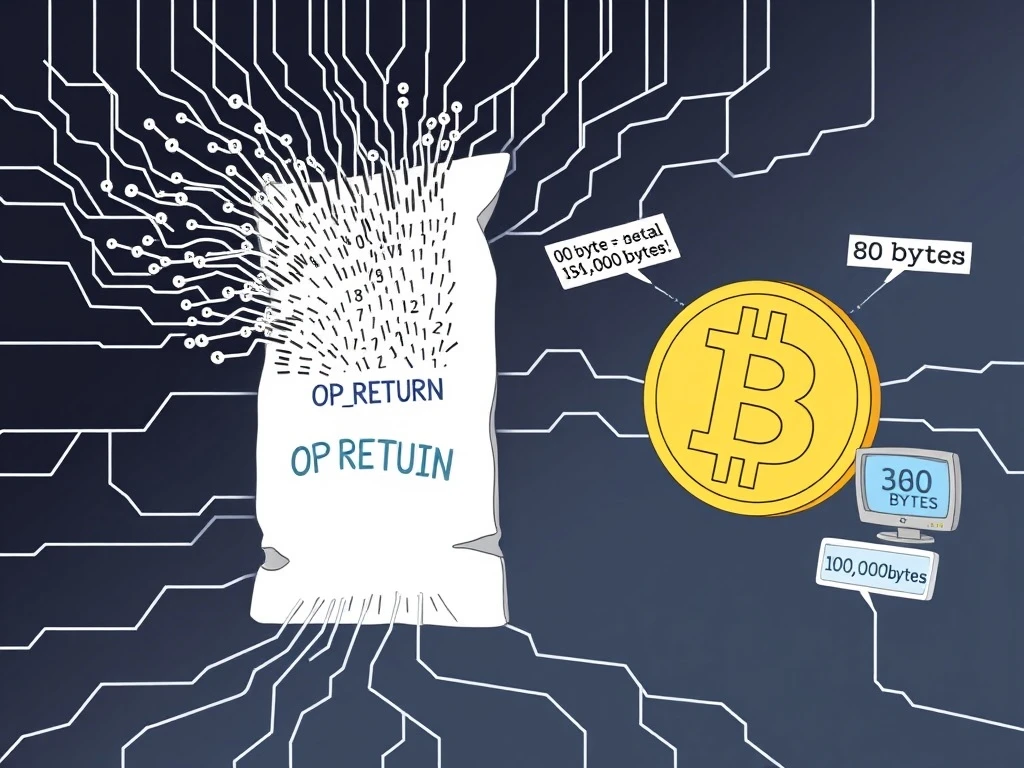Controversial Bitcoin Core v30 Update Unleashes Debate Over OP_RETURN Data Limit

Bitcoin Core v30 has officially gone live, sparking significant debate across the cryptocurrency community. This major Bitcoin network update introduces a controversial change: a drastic increase to the OP_RETURN data limit. Node operators and developers are now grappling with its implications for the network’s future. The update marks a pivotal moment for Bitcoin’s ongoing evolution and its approach to blockchain scalability. This development requires close attention from all Bitcoin node operators.
Unpacking the Bitcoin Core v30 Update and Its Core Changes
Bitcoin Core v30 arrived on Saturday, bringing several architectural and performance enhancements. Notably, it introduces optional encrypted connections between nodes. This feature significantly improves privacy for users. However, the most significant and widely discussed change involves the OP_RETURN data limit. Previously, this limit stood at a modest 80 bytes. The new update expands it dramatically to a staggering 100,000 bytes. This allows for embedding much larger amounts of non-financial data directly into Bitcoin transactions. Such a shift opens new avenues for decentralized applications. Yet, it also ignites heated discussions about Bitcoin’s core purpose and blockchain scalability. Older versions, specifically 27.x and below, are now at their ‘End of Life.’ They will no longer receive further updates or security patches. Therefore, upgrading becomes essential for many users to maintain network compatibility and security. This decision underscores the continuous development cycle of the Bitcoin network update process.
The Controversial OP_RETURN Data Limit: Innovation vs. Purity
The expanded OP_RETURN data limit quickly became the focal point of community discussion. Proponents argue this change fosters crucial innovation. It enables more sophisticated decentralized applications (dApps) on the Bitcoin network. For instance, developers can now embed richer metadata, represent digital assets more complexly, or facilitate new types of smart contract proxies. Alex Bergeron, Ark Labs Ecosystem Lead, expressed enthusiasm. He stated intentions to use the additional space. Bergeron believes it can make Bitcoin “more like Ethereum, except better.” Satoshi Labs co-founder Pavol Rusnak also supports Bitcoin Core v30. He cited the “great development team” and “peer-reviewed code.” These supporters view the update as a positive step. They see it as essential for Bitcoin’s continued relevance and utility in a rapidly evolving crypto landscape. However, a strong counter-narrative exists. Many Bitcoin purists believe the network should remain solely for financial transactions. They argue that embedding large amounts of non-financial data deviates from this fundamental principle. This group fears potential consequences for the network’s integrity. They raise concerns about increased blockchain bloat. Furthermore, higher Bitcoin node operators costs worry many participants. The debate mirrors past conflicts within the Bitcoin community, highlighting deep philosophical divides.
Echoes of the Past: Bitcoin Network Update and Scalability Debates
This current dispute strongly echoes the 2017 block size wars. That conflict ultimately led to the Bitcoin Cash hard fork. While Bitcoin Core v30 is not a protocol change, the intensity of the debate feels remarkably similar. Critics warn of potential fragmentation. They believe the network could face new challenges to its unity and shared vision. Jameson Lopp, CasaHODL co-founder, stands firmly behind Bitcoin Core v30. He sees the update as beneficial for progress. Yet, opponents foresee serious issues. They argue that allowing extensive data embedding contradicts Bitcoin’s original vision. This vision describes Bitcoin as a peer-to-peer electronic cash system. Increased data could strain network resources. It might also reduce transaction efficiency and overall blockchain scalability. The core question remains: What is Bitcoin’s ultimate purpose? Should it serve as a minimalist financial ledger? Or should it evolve into a platform for diverse data applications? This tension drives much of the ongoing discussion. It highlights fundamental disagreements about Bitcoin’s future trajectory. Therefore, the community watches closely, anticipating the long-term effects of this significant Bitcoin network update.
Practical Implications for Bitcoin Node Operators and Legal Concerns
The Bitcoin Core v30 update poses particular challenges for Bitcoin node operators. Many operators worry about the practical implications. Increased data limits could lead to significantly larger blockchain sizes. This, in turn, demands more storage and bandwidth resources. Consequently, operating a full node becomes more expensive and resource-intensive. Pioneer cryptographer Nick Szabo voiced significant concerns. He highlighted potential legal liabilities. Szabo warned operators could risk hosting “illegal data” unknowingly. He urged safeguards to allow non-disruptive deletion of such content. Without these, operators might face criminal charges for data they merely relay. Szabo strongly recommended against upgrading to Core v30. He suggested running alternative software like “Knots” instead. Knots allows operators to enforce strict data size limits. For example, it can maintain the original 80-byte limit. This effectively filters out transactions exceeding their preferred data threshold. Luke Dashjr, Knots founder, has been a vocal critic of the Core update. His software offers a clear workaround. It appeals to those prioritizing network minimalism and legal safety. Data reveals significant adoption of Knots. BitRef indicates 5,114 Knots nodes exist. This represents 21.48% of all Bitcoin nodes. This substantial number clearly shows the community’s division. Many prefer to avoid the v30 changes and their potential for blockchain bloat.
Navigating Bitcoin’s Evolving Path
The Bitcoin Core v30 update undeniably marks a significant moment. Its controversial OP_RETURN data limit increase reshapes possibilities for the Bitcoin network update. It simultaneously reignites deep philosophical debates. The community remains divided between fostering innovation and preserving perceived purity. As a result, the future direction of Bitcoin will depend on these ongoing discussions. Bitcoin node operators, developers, and users must all consider the long-term implications. The update could pave the way for exciting new dApps and enhanced utility. Conversely, it might introduce unforeseen challenges related to blockchain scalability and network decentralization. Ultimately, how the community adapts to this change will shape Bitcoin’s long-term trajectory. This unfolding story deserves close attention from everyone invested in the future of digital currency.









